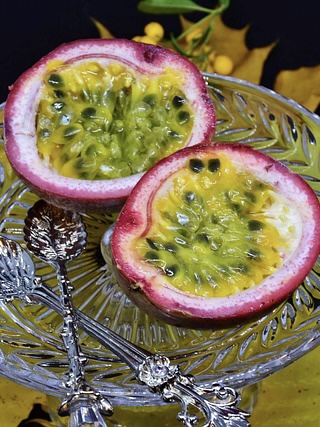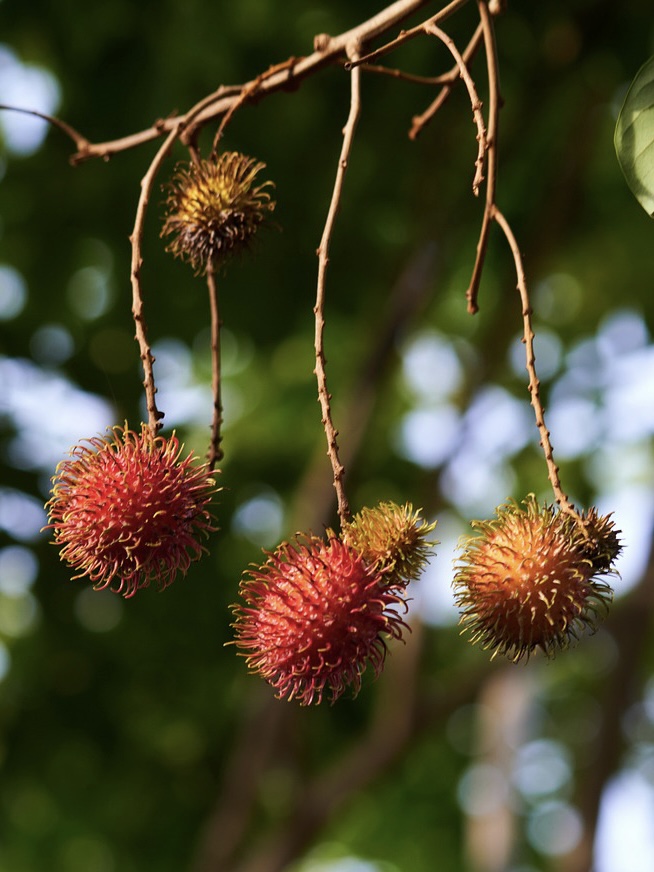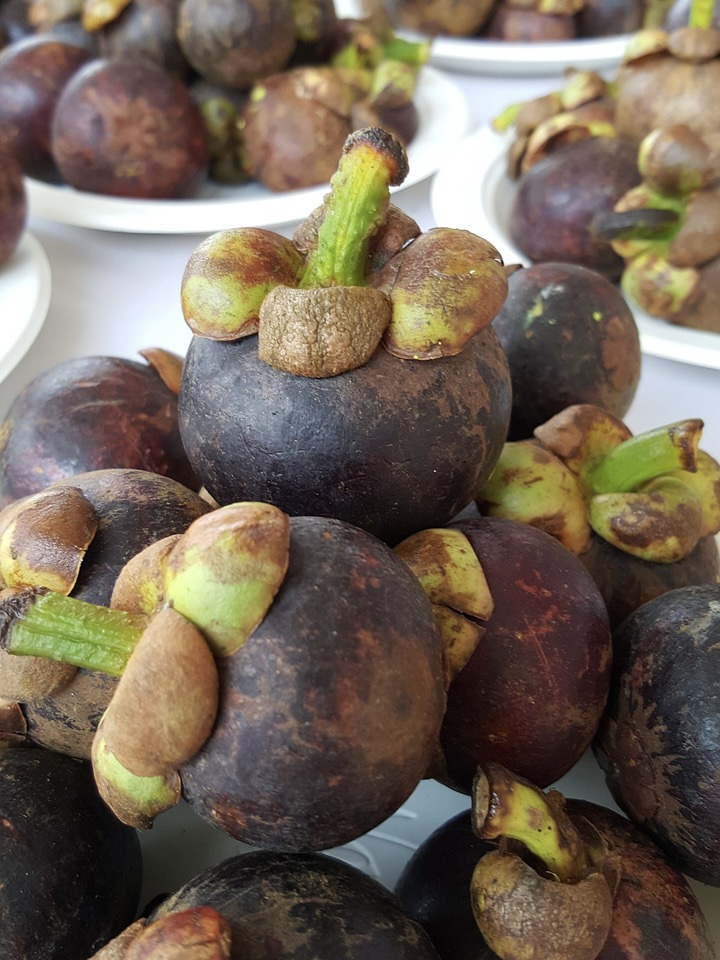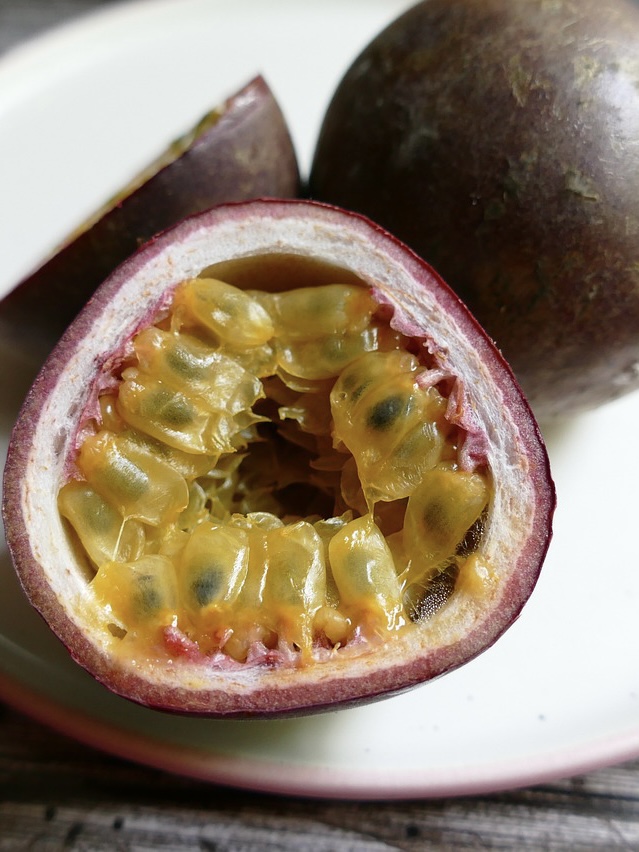Fruit Paradise or what fruits to eat in Asia
Hello Folks!
Kupala Night or Midsummer Night, started summer in Europe.
In Asia, the rainy season is in full swing.
It's the perfect time to taste the fruits, isn't it?
In Asia, the richness and variety of fruits is extraordinary. The continent is home to many exotic and delicious fruits that are unique to the region, although many came to Asia with the Spanish colonizers from the Caribbean.
Here's a story about the most mysterious fruits: dragon fruit (pitaya), rambutan, mangosteen, star apple and maracuja. That is the first part of "Fruit's Bamboo Tales".
Next week, in the second part, we will meet more Asian heroes. Lychee, banana, pineapple and mango, which is my favorite fruit in Asia.
There is one more, the most important one, the King of fruits, Durian. About how it tastes, looks and whether durian can kill a person, I wrote extensively in a separate article and I warmly start reading it by clicking on this sentence.
These fruits are just a few examples of the richness of fruits in Asia. This continent is full of a variety of flavors and aromas that make discovering its culinary treasures a real adventure for gourmets from around the world.
They will be some funny stories. After all, we're on vacation! You can read to your children and grandchildren.

We'll start with… dragon fruit.
Get ready for the story of one of the most mysterious fruits, the dragon fruit, also known as pitaya.
Our story begins in the dense forests of the tropical jungle, where mysterious fruit plants hide their treasures. Resembling an exotic bomb, the dragon fruit has an unusual pedigree.
Legends say that in distant times, on the islands of Southeast Asia, volcanic rocks and atmospheric heat created ideal conditions for the birth of this unique fruit. One day, during one of the violent earthquakes, a beautiful plant with intense pink and green petals bloomed on the coast. Its exotic appearance and unique aromas attracted the attention of the locals, who dubbed it "dragon flower".
But what was hidden inside was a real treasure. After a short time, inflorescences began to form, containing dozens of small, edible seeds. These seeds, which later became known as dragon fruit, were sweet, juicy, and had amazing health benefits.

The fame of the dragon fruit quickly spread throughout Southeast Asia. Travelers and traders began to export these unique fruits to other continents, and they won the hearts of people around the world with their unusual taste and beautiful appearance.
Dragon fruit has also gained popularity due to its health properties. It is rich in vitamins, minerals and antioxidants that contribute to overall well-being and health. In some regions, it is even considered the fruit of longevity and a symbol of good luck.
Today, dragon fruit can be found in many parts of the world, both at fruit stands and in high-end restaurants. Their popularity continues to grow, and people are experimenting with different recipes to get the most out of this fruit. You can eat it raw, add it to salads, smoothies and even create tasty desserts.
Growing Dragon Fruit is as interesting as its history. Cactus species from which dragon fruit is obtained need partial shade, require a clear division into the dry and rainy seasons, and to ensure high yields, hectare plantations are illuminated at night with LED lamps.
On the weighted shoots, bent towards the ground, typical of cacti, a large fruit is formed. It is these plantations that you can see during the night approach to Saigon. However, before the fruit is formed, the flower appears. Big, white and fragrant. What's more, this cactus only blooms at night. For this reason, Dragon Fruit is called the "Queen of the Night" or "Moon Flower".

Throughout the Mekong Delta, thousands of hectares have been devoted to the cultivation of dragon fruit.
The taste of pitai is slightly sweet and refreshing, and eating it is a real feast for the senses. Especially if it has just been plucked from the bush and is still warmed up by the tropical sun.
Shaggy cousin with messy hair… rambutan
Rambutan is another fascinating fruit native to Southeast Asia, mainly Indonesia and Malaysia. Its name comes from the Malay word "rambut" which means "hair". In Vietnam, rambutan is called "chôm chôm", which translates to "messy hair", due to the thorns on the skin of the fruit.
The external appearance of this fruit is unusual - it has red or yellow spikes resembling hair. However, once the spines are removed, the juicy and sweet fleshy inside is revealed. Rambutan has a greenish-red skin and soft, light flesh. Its taste is sweet and refreshing, reminiscent of the taste of grapes. Rambutan is often eaten as a fresh fruit, but can also be found in desserts and drinks.
Unripe rambutan fruits are used to relieve diarrhea and dysentery. Poultices of rambutan leaves or roots on the temples help in relieving headaches and fevers. A decoction of the bark is used to produce remedies for thrush.
The fruit itself is associated with joy, fun and a smile. Why?
Once upon a time, in a jungle full of strange creatures and exotic plants, a tiny but extremely brave fruit named Rambutan was born. He was extremely happy to be a rambutan because he loved adventures and new experiences.
One day, Rambutan decided to leave the tree where he was born and go on a journey around the world. He knew he had to be careful because danger lurked at every turn. But Rambutan was not afraid of challenges and with a smile on his face set off into the unknown. During his journey, Rambutan encountered other fruits such as mango, banana and pineapple. Together they formed a team of fruit travelers who had many adventures. Once they fell into a powerful waterfall and were forced to swim in the water, using their skins as dinghies. Another time they found themselves on the edge of a high mountain where they had to slide down into a valley ... on their backs, of course!
But the most unusual adventure of Rambutan was the meeting with monkeys who fell in love with its taste. The monkeys were so fascinated by Rambutan that they decided to learn how to dance by holding it on their tails. The whole jungle came to life with the sounds of laughter and cheers.
And so, Rambutan became a legendary fruit that brought smiles and fun wherever it went. His story reminds us that it is worth being brave and enjoying the journey through life.
So now, when you see a rambutan on a store shelf, remember its great history and let it bring a smile to your face!
There can only be one king. Are you sure? Fight for the Throne. Mangosteen...
I would like to tell you a story about an amazing fruit called mangosteen!
It comes mainly from Indonesia, Malaysia and Thailand. This fruit has a dark purple, hard skin that protects the delicate flesh. Mangosteen flesh is white, juicy and sweet, with a slightly sour aftertaste. In Asia, it is valued for both its taste and its health benefits. Mangosteen is rich in antioxidants and considered a nourishing fruit. It can be eaten raw or used in juices, compotes and desserts.
It's such a funny story that it's hard to believe that such a thing exists.
Well, unless you are an employee or hotel owner and you have to throw away dozens of pillowcases and sheets because someone just stained them with mangosteen juice. These stains cannot be removed. Therefore, in Asia there is a general ban on bringing mangosteen fruit into hotels.

One day in the tropical jungle, somewhere deep in Borneo, lived a little creature named Manny Mangosteen. It was a small purple creature with pink cheeks and a green tail. His main passion was discovering new flavors and fruits, so every day Manny set off on a journey through the jungle in search of them.
One morning, Manny heard a loud bang and a trace of a bright flash. Excited and curious, he set off towards the sound. When he arrived, he found scattered fruit and a tree that seemed completely alien. The tree had large, dark green leaves and was full of hanging fruit shaped like little balls. Their skin was purple and had thin green parts on top.
Manny glanced at one of the fruits and thought, "This must be something really special! It looks so different from anything I've ever seen!" Without thinking, he plucked the fruit and with great suspicion brought it to his lips. In one bite, he slammed it into his little mouth and... WOW! An explosion of flavor spread in his mouth. It was a taste he had never experienced before - sweet, slightly sour and slightly floral.
Manny immediately fell in love with the fruit and named it mangosteen, after his own name. He knew he had to share this discovery with the other creatures of the jungle. So he took a basket full of mangosteens with him and set out, crossing streams and winding paths to reach the animal village.
When Manny entered the village, all the animals froze in amazement. They had never seen such a fruit before. They were fascinated by the purple skin and the wonderful taste that came from inside them. Soon, mangosteen became the biggest hit among the people of the jungle. The animals danced, sang and celebrated in honor of Manny and his discovery. Mangosteen has become a symbol of joy and friendship among all creatures of the jungle.
And so, thanks to a little creature named Manny, the mangosteen won the hearts of animals and became one of the most popular fruits in the jungle. Since then, everyone who tries mangosteen falls in love and smiles on their faces. And Manny? Well, he continues his search for flavors and discovering new fruits, hoping for more unforgettable adventures! And people? Well, it is said that when you eat mangosteen, the pigments pass into the skin, which is why Asians have darker complexions.
Legend, legend and we have a serious problem here. Mangosteen is called the "King of Fruits" in an attempt to overthrow durian. They're equal in one thing - they're banned from hotels.
As for me, durian is my king. What's yours?

Follow the starlight... and you will see the Star Apple
Star apple, also called blueberry, is a fruit with a green or purple skin. Inside is a whitish flesh that is sweet and creamy. Star apple has a delicate flavor and is often eaten raw as a snack or in fruit salads. It can also be used to prepare juices and desserts.
The Star Apple fruit, also known as Pureblood Fruit or Caimito Fruit, is an exotic fruit native to tropical climates. The history of this fruit dates back to Central America and the Caribbean.
Originally, Star Apple was grown in Mexico, Costa Rica and other Central American countries. It then spread to other regions such as Cuba, Jamaica and Puerto Rico. It is now also grown in many other tropical countries around the world. In Asia, it comes mainly from the Philippines.
The name "Star Apple" refers to the characteristic appearance of the fruit. When you cut it in half, you will see a star in the middle, which consists of a white, soft flesh covering the seeds. The flesh has a sweet taste and the texture is silky and creamy.

Star Apple also has different varieties in terms of skin color and flesh. It may have a purple, greenish or red skin and the flesh may be white, green or purple.
The Star Apple fruit is popular for its taste, but also for its health benefits. It is rich in vitamins such as vitamin C and vitamin A, and minerals such as calcium, phosphorus and iron. Star Apple also has anti-cancer and antioxidant properties.
Due to its exotic origins, Star Apple is exported to other parts of the world where it is prized as a delicacy fruit. It can be eaten raw, added to fruit salads or used to prepare desserts and drinks.
The history of Star Apple is related to the traditions and culture of the regions where it is grown. Its taste and appearance have made it the favorite fruit of many people who appreciate exotic fruits and their unique taste sensations.

And this fruit has its own legend.
Once upon a time, in a jungle full of sunlight, there lived a small fruit. But this fruit was not ordinary, no, no! He had a unique power - he shone like a star in the sky, which is why he was called "Star Apple".
As soon as the Star Apple matured, a mysterious light spread around it, as if a piece of a star had fallen from the sky. It was so enticing that the animals of the jungle could not help but come from far and wide to admire its brilliance and taste its sweet nectar.
The fruit was so tasty that everyone who tried it was delighted. One bite of Star Apple was said to provide energy for the day and bring good luck to those who were honored to taste it.
But Star Apple was fickle, oh yeah! He did not want to grow in ordinary places. He needed to have his own unique place to grow. So he chose a place with beautiful views and inaccessible to others - on top of the tallest tree in the jungle.
No matter how hard the animals tried to reach it, no one was able to break the Star Apple without help. He was a bit like a jungle celebrity who wanted to be admired from afar.
But don't worry, because the jungle was full of creatures full of determination. A large, gentle elephant came to the rescue, his tall trunk reached up and grabbed the Star Apple, giving it to other animals. The little ants jumped on the elephant's trunk to improve their balance, and the echidnas formed "living bridges" to deliver the fruit to their friends in the jungle.
Thanks to this cooperation, the entire animal community enjoyed the taste of the Star Apple.
And Star Apple? He was popular, he walked the sky smiling and proud, knowing that he was one of the most special fruits in all the jungle.
And so ends this funny story about Star Apple. What we can take away from it is a reminder of the importance of collaboration and that our unique talents can be used to bring joy to others. Isn't it wonderful?

Courage and happiness. The history of passion fruit…
This fruit is the favorite of millions of people. Adults and children love it. He came to Asia from South America, thanks to ... Marak ;) ...
Ready for another story?
Once upon a time, in a tropical jungle, in a remote corner of South America, there was a fruit kingdom where various fruits competed for the title of the most delicious and popular among people. One of the lesser known fruits in the kingdom was a small orange fruit called Marak. He was a bit shy and often felt underestimated by others.
One day, Marak decided that he wanted to change his life and become a great fruit that everyone would adore. He decided to embark on a journey through the jungle to find a magical fountain that was said to have extraordinary powers and be able to grant wishes. Marak was convinced that the power of the fountain would make him famous and respected by everyone.
Wandering through the dense forest, Marak came across many other fruits that joined him in his search for the magical fountain. There was Mango, who wanted to be the juiciest fruit in the world, Pineapple, who dreamed of being the king of exotic fruits, and Banana, who wanted to be the most popular smoothie ingredient.
After a long journey full of dangers, they finally found the fountain. The fruit team was excited and everyone started making their wishes. Marak, standing in front of the magic fountain, exclaimed: "I want to be the tastiest fruit in the world!" Then a great fountain of passion fruit juice gushed out of the fountain, flooding Maraka and the rest of the fruit.
When the team came out of the fountain, they noticed that the Marak became extremely tasty and aromatic. He was so special that everyone started to love him. Its taste was sweet and sour and tropical at the same time, and its smell attracted insects and people from afar.
Marak has since become the most coveted fruit in the kingdom. Everyone wanted it in their kitchen, and travelers from other lands came to try it. Marak, which previously felt unnoticed, has become a real star in the world of fruit.
And so the story of the maracuja fruit reminds us that sometimes we have to dare and take risks to achieve our goals.
Sometimes the smallest fruit can achieve the greatest success and turn into something special.
It's the same with people, isn't it?

Phew… we've reached the end of the first part of the story about fruits in Asia.
These are just a few examples of the richness and variety of fruits in Asia. This continent offers fruits with unimaginable flavors, shapes, colors and textures. Thanks to this diversity, Asia has a reputation as a paradise for fruit lovers who can discover new flavors and culinary experiences at every turn.
It's time to reach for your afternoon dose of vitamins. I choose rambutan.
And what is your choice?
More articles


Pages created with WebWave


















